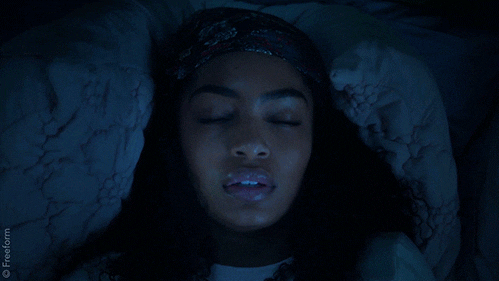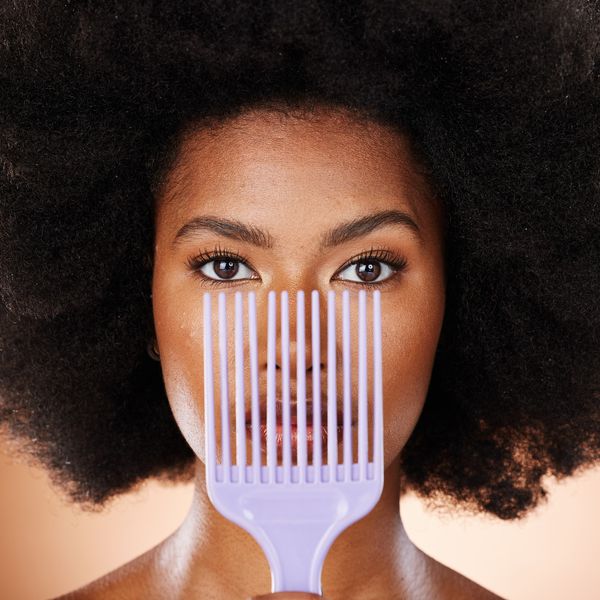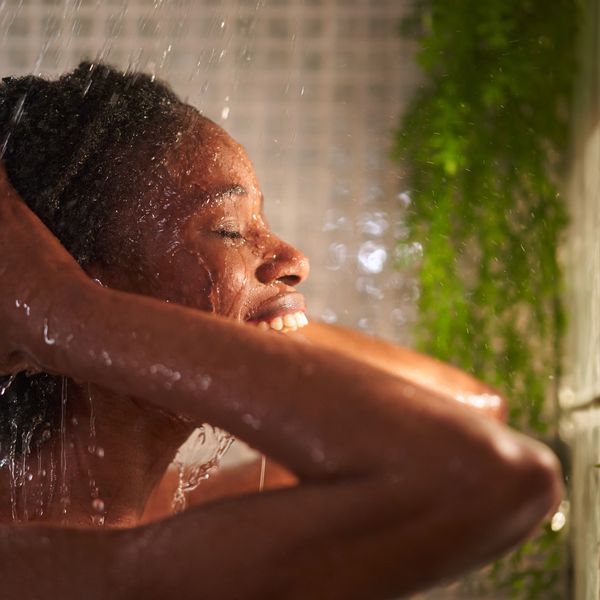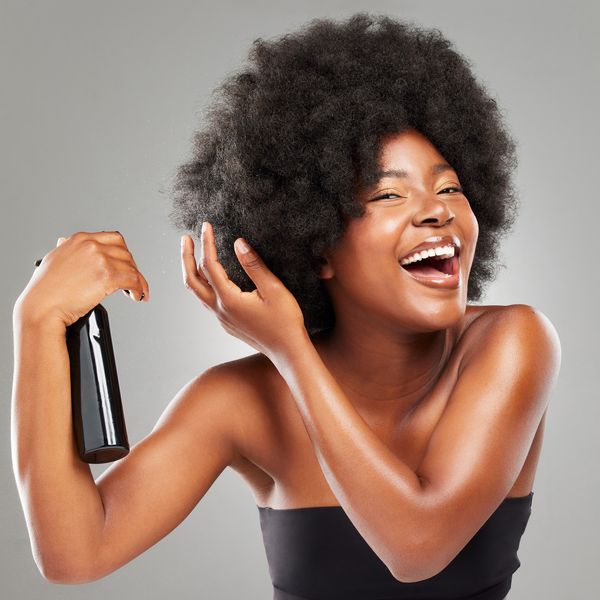
It's kinda crazy what inspired me to pitch and then pen this article. I was watching Usher's visual for "Bad Habits" while trying to figure out why a particular small area of my hair was thinner than it needed to be. I came to the conclusion that it was because I was manipulating it too much by always taking that particular cornrow down and braiding it up again. And that got me to thinking about so many of the bad natural hair habits that a lot of us have; ones that prevent us from getting the long-term hair results that we want.
If you're sick of your own tresses not flourishing as much as you would like, take a moment to see if any of these habits are ones that you definitely need to break.
1. Keeping Your Protective Style in Longer Than You Should
I don't know one naturalista who hasn't heard that one of the best ways to achieve length retention is by putting their hair up in a protective style. As I said a second ago, my hair is currently in cornrows (a personal favorite style of choice). I dig them because, not only do they keep me from having my hands in my tresses all of the time, but protective styles are also a great way to protect my ends as well (damaged ends are the main reason why most of us don't get the inches that we want). Still, too much of a good thing can easily work against you.
In this case, if you've got your hair in some braids or twists (via your natural hair), they really need to remain in there for no longer than a couple of weeks. Braids and twists with extensions, you're pushing it if you keep them in for longer than two months. The reason why is because your hair and scalp need to be thoroughly washed and to take a break from the stress that protective styles can cause if you've got them in for too long. One day, I'm gonna share how protective styles can actually be the reason why your hair isn't growing. For now, though, just don't keep them in for a billion years. It's the kind of bad habit that doesn't get discussed, nearly enough.
2. Using Too Many Damn Products in Your Hair
The beauty industry is a billion-dollar one and we as Black women play a HUGE role in why that is the case. That said, I know there are tons of products out here that make all sorts of promises. But you've gotta remember that companies are looking to make revenue. This means that if they've gotta lie to you and say they have a serum that will fix your split ends (nothing fixes split ends; you have to trim them), that is exactly what they will do.
Anyway, while I'm all about finding products that work best for your hair if you use a lot of them at the same time or you keep switching up, all that's gonna do is either weigh your hair down and clog up your hair follicles (not good) or end up damaging your hair because not all products are created equal and your hair shouldn't be treated as some guinea pig or science project. It typically takes about two months to figure out if something is really your jam on the product testing tip. Try a couple of things out at a time and stick to what works for you, even if it's only a few products. Less is more is always best when it comes to hair care.
3. Not Knowing Your Hair Type and Texture
Let me tell it, I think women struggle with knowing what their hair type is about as much as they struggle with figuring out their correct bra size. When it comes to hair type, the numbers run from 1-4. 1 is straight. 2 is wavy. 3 is curly and 4 is coily. Then there are letters that go with each number, ranging from A-C. A is fine. B is medium. C is coarse. As far as your "numbers" go, YouTubers like Angela C. Styles, IAMTRAEH, and LavishlyBritt all have videos that break hair types down pretty well. As far as your hair's texture, a cool figuring-it-out hack is to take a piece of thread and lay it on a flat surface. Then place a strand of your own hair beside it. If your hair appears thinner than the thread, your hair is fine. If it's the same size, your hair is medium. If it's bigger, it's coarser.
Having this information is essential because it can help you to better understand how to properly care for your hair, what products work best, and ultimately how to keep it thriving. For some tips on all of these things, go to YouTube and put your hair type and texture, along with "natural hair" in the search field and you will see literal days' worth of videos pop up so that you can get to know your hair, even better.
4. Using the “Wrong” Styling Tools for Your Natural Hair
A lot of stylists will tell you that using your hands to detangle and style your hair as much as possible is oftentimes a good look because you can be gentler with your locks than you can with styling tools. But when it comes to the things that you absolutely do need, make sure you've got—a wide-tooth comb; some plastic hair clips (the metal ones tend to snag and tear); a Denman brush; a hair steamer (to lock in moisture); a microfiber towel (it's easier on your hair during wash days) and a blow dryer for your hair type (Red by Kiss Blow Dryer gets a lot of praise if you're a 4-type).
While this is a basic list, the main thing to keep in mind is a lot of metal, a ton of heat or anything that will cause your hair to snag and tear are absolutely no-nos. You really don't need a ton of styling tools; just things that will make getting the results that you want as easy as possible without creating any drama in the process on those pretty tresses of yours.
5. Mishandling Wet Hair During Wash Days
Your hair is definitely the most fragile when it's wet. That's why it's best to detangle your tresses with your fingers as much as possible, to deep condition after shampooing so that your hair is more manageable, and to apply a product that has some "slip" to it when you're using a detangling comb or you're doing something like braiding or twisting your hair for a braid out or twist out. Otherwise, you could end up ripping some of your hair out or weakening the cuticles during the styling process. As far as slip goes, if you'd like a little help figuring out which product would work best, Naturally Curly gave some slip awards to a few. You can check them out here.
6. Trimming Your Hair More than Dusting
One of the reasons why I stopped going to see a professional stylist was because far too many of them don't seem to know the difference between dusting and trimming. Hmph. I've always wondered if a lot of stylists have a secret vendetta against their clients gaining inches because I don't always need a bob— thank you, very much. Whew. Plus, as I've learned more about what does and doesn't work for my hair, I've become a big fan of dusting. Dusting is about getting rid of the raggedy or split ends that you may have without getting rid of 2-4 inches of hair in the process.
If you're nervous about attempting this, the main thing to keep in mind is you need a pair of sharp shears and a good amount of patience. Click here, here and here to watch some videos on how to dust.
Oh, and for any stylists that may have side-eyed me for what I said, I know there are some great ones out there and that some folks wouldn't be able to walk outta the house without one. At the same time, I believe a good one also isn't scissor happy. I'm thinking that we all can agree on that.
7. Having a Complex Relationship with Heat
Contrary to popular belief, I personally don't think that heat is the enemy; I think using heat the wrong way is, though. Back when I got on board with the whole "heat is the devil" movement, I actually experienced a lot more breakage than I do now that I blow my hair out every wash day and then leave it in a protective style (other than the weekends) until the next wash day. I believe it's because this method stretches out my hair so that there is less tangling and it also helps me to nurture my ends easier.
Anyway, that's not to say that huge mistakes aren't oftentimes made in this lane, mostly because people use the wrong kind of heating tools, apply them when they're too hot and/or use them too often. If you're in search of a good blow dryer for your natural hair, Byrdie recently published an article that features 12 (click here). After getting one, always make sure that your blow dryer is on low-to-medium heat and that you ONLY use it once your hair is about 60 percent dry on its own (the drier it is, the less you will be able to singe it). And try not to apply heat more than 2-5 times a month. More than that can definitely damage your hair and even alter your natural curl pattern.
8. Being High-Maintenance with Your Edges
Lawd, the internet. I'm pretty sure some of y'all saw the post of the young lady who mistook Gorilla Snot (which is already quite a beast when it comes to laying hair down) for Gorilla Glue. Well, at the time that I'm writing this, her hair literally hasn't moved in a month. Like…at all which resulted in her going to the ER (check her take on it here and a radio interview with her here). When I watched the video, the first thing that came to my mind is how obsessed a lot of us are with keeping our edges as laid as possible.
Listen, there's no time to get into how I believe that European culture has played a certain role in us having a preoccupation with baby hairs as grown women (goodness). For now, I'll just say that probably the most fragile parts of your hair are your edges and nape. So, constantly weakening your edges' hair follicles by always brushing them down, drying that part of your hair out with gels, and always applying pressure with braids, lace fronts and wigs are all surefire ways for your edges to either thin out or bald altogether.
If you must gel those babies down, make sure to use a non-alcohol gel (Allure published a feature on some of the best edge controls around; check it out here) and definitely give that area a break a few days a week. Sleek edges are cool, but you know what's even better? Having edges, period.
9. Jacking Up Your Wash ‘N Go
When it comes to low-manipulation hairstyles, wash 'n gos always top the list because you don't have to do a lot of styling and touching of your tresses in order to end up with a really cute look. That doesn't mean that too much of a good thing can't go awry though. The wrong products, tugging too much on your hair while it's wet and not knowing how to cultivate a bedtime routine that will result in you messing with your hair as little as possible the following morning all have to be factored in to make this a good idea for your natural hair texture.
If you want to make sure that this heat-free look goes off without a hitch—wash your hair with a sulfate-free shampoo; deep condition your locks; rinse your hair in cool water (it will keep your cuticles smooth); apply a curl cream (if you've got tighter coils) or add a carrier oil as a base to it (if you've got a looser curl texture) to set your curls, and keep your hands COMPLETELY out of your hair until your tresses dry (otherwise, you could end up with a significant amount of frizz). Wrap your hair up with a silk scarf or satin bonnet at night and refresh in the morning with a light leave-in conditioner. And try and let your wash 'n go be for about a week. Remember, low manipulation is always the key to stronger hair. You can get some other wash 'n go hacks by checking out this video, this video, this video, this video and this video.
10. Being Too Reliant on Your Wigs
Wigs can be dope; especially the kind that exists these days because I promise you that some, I can't even tell that they are wigs at all (like this line right here). Not only can wigs help you to avoid over-manipulating your hair, but they can also protect your tresses from outer elements, encourage your styling creativity without a lot of drama, and save you a ton of time when it comes to your morning routine.
Just remember that a wig is not your natural hair (no matter how much it may look or feel like it). If you've got a human hair well-secured, it can last for up to six weeks (if you take care of your natural hair that's underneath); just don't go beyond that. As far as sleeping in wigs, it really is best to remove them. If you opt not to, don't go more than a few days without doing so. Your hair and scalp need to breathe. Your edges need a bit of a break from the stress and tension of the wig too.
11. Not Taking a Multivitamin
There is plenty of data that says most of us don't get nearly enough nutrients from food alone. This is where multivitamins come in. They are a great way to supplement what you may be lacking which can result in everything from a strengthened immune system and healthier heart to more energy and beautiful hair, skin and nails. There are loads of vitamins on the market, so it's kind of hard to recommend a specific brand. You might want to look for one that specifically says "for hair, skin and nails" on it. Whatever you do, just make sure there are vitamins A, B12, C and E, iron, biotin and zinc in the product that you decide to go with. One that contains collagen is definitely a bonus. Oh, and if you opt for a liquid form, not only does it hit your system faster, it tends to be more potent too.
12. Stressing Out
If there is one thing that I have learned to become more and more intentional about, it's not letting any person, place, thing or idea stress me out. It's just not worth it. PERIOD. This includes when it comes to protecting my hair. Did you know that constant stress can throw off your cortisol levels and literally push your hair into a resting phase that can hinder it from growing? No joke. So, if you've got some job or man who is driving you up the wall and you're noticing some shedding or even thinning as far as your hair is concerned, don't tell yourself that it's all in your head. There is a very real chance that you are going bald due to anxiety. Release what's got you in that state. Your hair will thank you for it.
BONUS: STOP COMPARING
Iyanla Vanzant once said, "Comparing yourself to others is an act of violence against your authentic self." Out of all of the mistakes that we could possibly make when it comes to our hair, I promise you that the biggest one is comparing your tresses to someone else's. When God made you, he took out just as much time as he did on his other daughters. Don't insult him by acting like you somehow got a shorter end of the deal because, I can say from very personal experience, that once you get a real understanding of how your own hair works, you'll come to adore its individuality. You really will.
You'll wake up knowing that your hair is a gift, that there isn't one thing wrong with it, and that you are truly blessed. That your Creator made not one mistake. Amen? Amen.
Featured image by Giphy
- How To Determine Your Hair Type - xoNecole: Women's Interest, Love, Wellness, Beauty ›
- Protective Styles Not Working - xoNecole: Women's Interest, Love, Wellness, Beauty ›
- Taking Care Of Your Natural Hair While Traveling - xoNecole: Women's Interest, Love, Wellness, Beauty ›
- Tracee Ellis Ross' 'Hair Tales' Is About More Than Hair - xoNecole: Women's Interest, Love, Wellness, Beauty ›
- Pattern Beauty Blow Dryer Review Tracee Ellis Ross - xoNecole: Women's Interest, Love, Wellness, Beauty ›
It's kinda wild that, in 2025, my byline will have appeared on this platform for (what?!) seven years. And yeah, when I'm not waxing poetic on here about sex, relationships and then...more sex and relationships, I am working as a certified marriage life coach, helping to birth babies (as a doula) or penning for other places (oftentimes under pen names).
As some of you know, something that I've been "threatening" to do for a few years now is write another book. Welp, October 2024 was the month that I "gave birth" to my third one: 'Inside of Me 2.0: My Story. With a 20-Year Lens'. It's fitting considering I hit a milestone during the same year.
Beyond that, Pumas and lip gloss are still my faves along with sweatshirts and tees that have a pro-Black message on them. I've also started really getting into big ass unique handbags and I'm always gonna have a signature scent that ain't nobody's business but my own.
As far as where to find me, I continue to be MIA on the social media front and I honestly don't know if that will ever change. Still, if you need to hit me up about something *that has nothing to do with pitching on the site (I'm gonna start ignoring those emails because...boundaries)*, hit me up at missnosipho@gmail.com. I'll do what I can. ;)
There’s just something about HBCU Homecoming that just hits different. Whether it’s your first time stepping onto the yard since graduation or you’re a regular at every Homecoming tailgate, HBCU pride is undeniable. It’s a vibrant celebration that unites the legacy of excellence and tradition with the energy and resilience of Black culture.
The experience goes beyond a typical college reunion; HBCU Homecoming is a family reunion, a fashion show, a cultural festival, and a week-long turn-up that embodies what it means to be unapologetically Black and educated. For HBCU alumni, the journey back to the yard each year is rooted in a love and pride that’s hard to put into words but impossible to deny.
From statement pieces to tech must-haves, every item represents the intersection of Black pride and HBCU love, ensuring that you show up to the yard in style and with intention. So whether you’re repping your alma mater for the first time since graduation or looking for fresh pieces to express your HBCU pride, these essentials will have you standing out, because, at HBCU Homecoming, it’s not just about showing up—it’s about showing out.
Thread Goals
diarrablu Jant Pants in Alia Noir

High-waisted, wide-legged, and ready to shut down the yard, the Jant Pants by diarrablu bring a whole new meaning to campus chic. Handcrafted in Dakar, Senegal, these free-flowing jacquard pants are perfect for stepping onto the yard with style and ease—making them a must-have for any HBCU alum’s closet.
Silver & Riley Convertible Executive Leather Bag Classic Size in Olive

This all-in-one luxury bag isn’t a bestseller for nothing. The Silver & Riley essential is made of Italian calfskin leather and thoughtfully designed, as it can be worn in four different ways: a shoulder bag, crossbody, a top handle, and a backpack. Chic and elegant, the Convertible Executive Leather bag is “the bag that every woman needs in her collection.”
Renowned Women's Intuition Cotton Graphic T-Shirt

Renowned
Renowned’s Women’s Intuition Cotton Graphic T-shirt features a bold graphic print inspired by the power and essence of women’s intuition. With its striking design, this all-cotton tee is a vibrant thing, making it a statement piece that celebrates feminine energy.
Mifland Million M Mesh Crop Shirt

Talk about bold, the Million M Mesh Crop Shirt combines edgy style with comfort, featuring Mifland’s signature print on a semi-see-through mesh fabric. Show up and show out in sophisticated flair.
HBCU Love FUBU
Melanin Is Life Melanated & Educated - I Love My HBCU Hoodie

Show off your HBCU love with this piece that represents everything you gained from your alma mater: a top-tier education, a community that lifts you up, and a deep sense of esteem for yourself and your culture. Wear it loud and proud, because being melanated and educated isn’t just a flex—it’s a legacy.
HBCU Culture Spelmanite Sweatshirt in Navy

Spelmanites, rep your Spelman pride with this unisex crewneck sweatshirt, designed for ultimate comfort and a relaxed fit. Made from a cozy cotton/polyester blend, this classic sweatshirt is as durable as it is stylish—making it an ideal piece for any Spelmanite showing love for their alma mater.
HBCU Culture Howard Is The Culture T-Shirt

Rock the ultimate flex by showcasing your Howard U love with HBCU Culture’s Howard Is The Culture t-shirt. This unisex tee offers a comfortable, relaxed fit that’s perfect for celebrating your HBCU spirit without sacrificing style or comfort.
DungeonForward FAMU - Strike Bucket - Reversible

DungeonForward’s Strike Bucket Hat brings versatility and style to the FAMU Crown collection with its reversible design, giving you two looks in one. Featuring a sleek black snakeskin-embossed brim lining and a bold outline Rattler emblem, this hat is all about repping your Rattler pride in style.
DungeonForward Savannah State University - HBCU Hat - TheYard

The Savannah State University HBCU Hat by DungeonForward is more than just a hat—it’s a symbol of Tiger pride and a nod to the culture. Perfect for gamedays, tailgates, or just showing off your HBCU love, this hat lets you carry a piece of the yard wherever you go.
Tech the Halls
Anker iPhone 16 Portable Charger, Nano Power Bank

Stay charged up with the Anker Nano Power Bank, which features dual USB-C ports, a foldable connector, and a compact design, making it perfect for those HBCU tailgates and late-night parties you pull up to.
Drip Check
Wisdom Frame 14 Square Sunglasses

Elevate your look with these angular square-frame sunglasses by Wisdom, bringing an ultramodern edge to any outfit. The sleek design makes them perfect for blocking out the haters while you stunt on the yard.
Coco and Breezy Eyewear Fortune in Gray Turquoise

The Fortune Glasses in Grey Turquoise is a bold statement piece to any Homecoming weekend ‘fit that “embody our fearless and outspoken DNA.” With their color and edgy design, these frames by Coco and Breezy are perfect for anyone looking to stand out and express their unapologetic confidence.
Howard U Lapel Pin

Rep your Bison pride wherever you go with this Howard U Lapel Pin from Pretty AmbVision. Whether adding it to your jacket, shirt, or bag, this pin is the perfect way to showcase your love for your alma mater while rocking your HBCU love with honor and distinction.
Mifland Standard Rucksack Mini

The Standard Rucksack is designed to evolve like that HBCU pride—getting richer, bolder, and better with time. Durable, stylish, and built to last, this Rucksack by Mifland is a timeless piece equipped with versatile carrying options and fully adjustable back straps for ultimate comfort.
Stay Fresh, Stay Blessed
Slip Pure Silk Sleep Mask in Pink

Keeping it cute starts with beauty sleep. This luxurious silk mask is an essential for a reason. If protecting your skin and waking up refreshed is your priority, look no further than this Homecoming essential.
Liquid I.V.® Hydration Multiplier Lemon Lime - Hydration Powder Packets

Stay hydrated and energized throughout Homecoming weekend with this Liquid I.V.® Hydration Multiplier in Lemon Lime. Just add a packet to your water bottle, and bless your body with 2-3 times more hydration than water with every packet. Because staying hydrated is the key to popping up and showing out all weekend long!
Loop Experience Plus Earplugs High Fidelity Hearing Protection

Designed for your hearing protection, these sleek earplugs reduce noise without compromising sound quality—perfect for enjoying the band’s halftime show, late-night parties, and DJ sets. Whether you’re front row at the step show or hitting the yard, your ears deserve to be protected in style!
Black Girl Magic Glass Cup

Sip in style and celebrate your melanin with the Black Girl Magic Glass Cup. Perfect for morning coffee, your favorite iced drink, or showing off your HBCU pride on the yard—this cup is all about keeping it cute while radiating your endless supply of Black Girl Magic.
Glow Up & Show Out
Black Girl Sunscreen SPF 30

What Homecoming weekend can be complete without an assist from this beauty find? Formulated to blend seamlessly into melanin-rich skin (no white-cast), protect your glow while you turn up with the Black Girl Sunscreen SPF 30.
Sienna Naturals Issa Rae's Wash Day Ritual Set

Issa Rae’s Wash Day Ritual Set from Sienna Naturals includes the H.A.PI. Shampoo, the Plant Power Repair Mask, Dew Magic, and Lock and Seal to get your crown right. Whether you’re repping your coils or rocking a new color on the yard, these products restore and nourish your strands, keeping your hair healthy, strong, and Homecoming-ready!
54 Thrones Ivorian Cocoa + Ghanaian Coconut Beauty Butter

Stay glowing from the tailgate to the after-party with the 54 Thrones Ivorian Cocoa + Ghanaian Coconut Beauty Butter. Infused with African-sourced ingredients, this rich, multi-purpose butter is the answer to keeping your skin soft and radiant through all the festivities all Homecoming long.
Saie Glossybounce Hydrating Lip Oil

Keep your lips looking luscious and nourished with the Saie Glossybounce Hydrating Lip Oil. Perfect for adding an extra pop to your pout before hitting the yard or freshening up between events, this lip oil is a beauty essential for staying camera-ready all weekend.
Join us in celebrating HBCU excellence! Check out our Best In Class hub for inspiring stories, empowering resources, and everything you need to embrace the HBCU experience.
Featured image by Visual Vic/Getty Images
Ananda Lewis Clarifies Why She Didn't Get A Mastectomy & Says She's Doing 'Better' After Stage IV Breast Cancer Diagnosis
Former MTV VJ Ananda Lewis received a lot of backlash from online critics after sharing she decided to forgo a double mastectomy. But there's more to the story.
Ananda was diagnosed with stage III breast cancer in 2019, and during a recent round table discussion with CNN's Stephanie Elam and Sara Sidner, she revealed that she decided not to get a double mastectomy and, now, she has stage IV cancer.
Following that interview, she clarified why she did not get the surgery. “The circumstances were not conducive to surgery because my tumor wasn’t aggressively growing at the time, and then COVID hit,” Ananda told The Epoch Times.
She opted for a cryoablation treatment instead, which uses extreme cold to destroy the cancer cells.
Another thing the 51-year-old wanted to clarify was whether she was dying. She said she is not. “Nothing happened. Today, I am fantastic. I may have felt like I was dying in February, but I’m not dying, and I’m definitely doing better than I was last October,” she said.
She is focused on taking care of herself and getting a "good 20 more years out of this body." She follows a keto diet and avoids alcohol, white flour and white sugar.
During the CNN roundtable discussion, the mother of one shared that she had an integrative approach to her treatment, which included traditional medicine and homeopathy methods such as red light therapy.
“My plan at first was to get out excessive toxins in my body. I felt like my body is intelligent, I know that to be true. Our bodies are brilliantly made,” she said.
“I decided to keep my tumor and try to work it out of my body a different way,” she continued. “Looking back on that, I go, ‘You know what? Maybe I should have.’
Ananda also admitted that she wasn't prioritizing early detection, such as getting mammograms. The former talk show host's mom also had breast cancer and chose to go the conventional route, which influenced her to go a non-traditional route.
As a content creator, Ananda uses her social media to inform others on the things she's learned about obtaining good health such as toxic items to through out of your pantry and the many benefits of water.
Let’s make things inbox official! Sign up for the xoNecole newsletter for love, wellness, career, and exclusive content delivered straight to your inbox.
Feature image by Paul Archuleta/Getty Images









